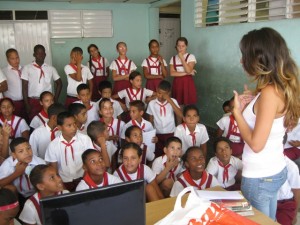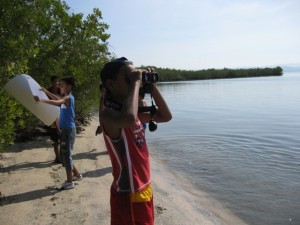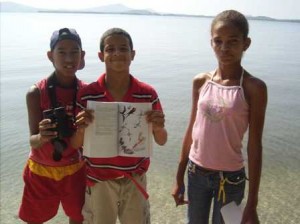
In the framework of the 2012 Endemic Birds of the Caribbean Festival, the Oriental Center of Ecosystems and Biodiversity (BIOECO) arrived in the city of Caimanera in the providence of Guantanamo to celebrate the international day of birds with children and adults. For the first time, some of the children that live in this marine village have been presented with the opportunity to connect with the interesting world of birds without having a cage stand between them. Those who were present, throughout the educational encounters and observatory session of aquatic birds, learned about how important the conservation of birds is for nature and life.

In the educational workshop with children from Wilfredo Gonce Cabrera Elementary School, topics like: Popular and scientific identification on the endemic birds of Cuba and the Caribbean; and Conservation and importance of birds, were covered. The first topic was developed through photo presentations of the endemic birds of Cuba and the Caribbean in which we, the investigators, would teach the children about the scientific names of the birds and they would teach us about the popular names, or at least by the name they know the birds as. In an integrative manner, all of us were subject to such activity and learned about the identification and importance of birds once the second topic for the workshop concluded. The number of us participants was more than 50 children and 6 adults.
Observing aquatic birds at the Guantanamo Bay: May 12, 2012
The village of Caimanera is located on the northeast side of Guantanamo Bay, which is found on the south coast of the old orient province. The Bay is considered as one of the largest in the country, it has various inlets and extensive mangroves. In one of the beaches localized in one of the mangrove zones of this beautiful bay, we created this aquatic birds observatory spot where some children, for the first time, experienced bird watching.

According to the methodology of the EESY (Ecological Education in the School Yard; EEPE in Spanish), the inquiry that was given to the children for them to work was: In a zone of Guantanamo Bay, from 9:30am. until 11:00 am. on the date of May 12, 2012, which are and how many bird species are there in the mangrove zone and in the ocean zone of the Bay?

In a general way we consider this day to having been a perfect one because we achieved to change the perception of these children on how to enjoy birds and because it seemed as if the birds knew what we were doing because we observed many Great Blue Herons (Ardea herodias), Brown Pelicans (Pelecanus occidentalis), Osprey (Pandion haliaetus), Laughing Gulls (Leucophaeus atricilla) and Magnificent Frigatebirds (Fregata magnificens). It was an incredible number and variety of birds that we were able to observe, the children felt happy and so did we.